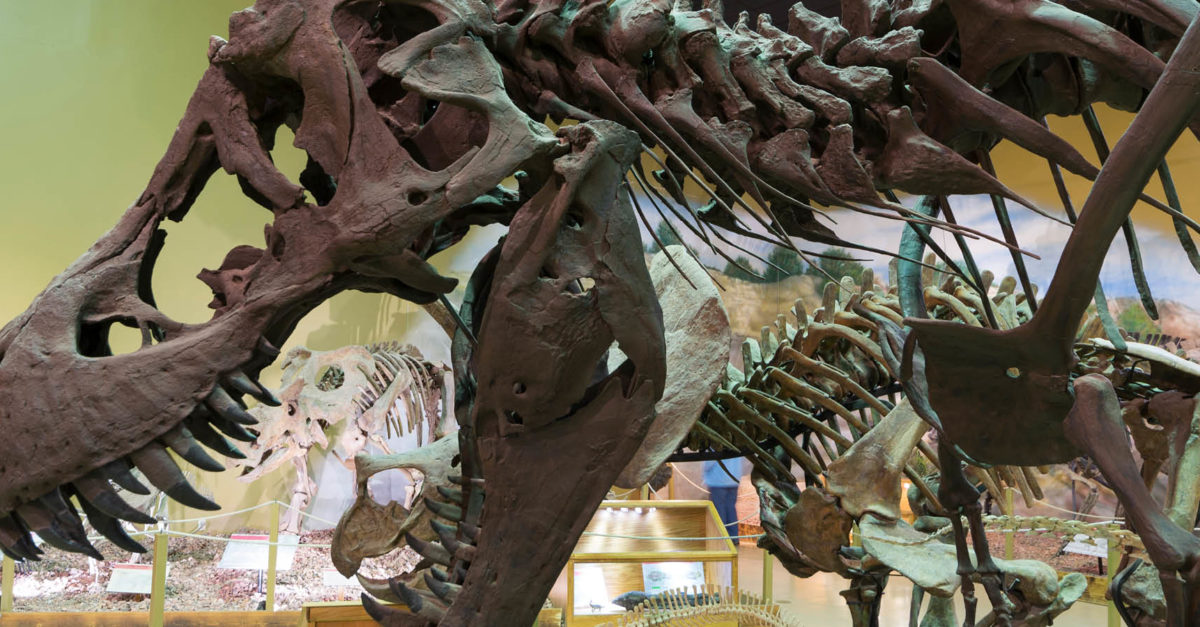Unearthing the Layers of Time: The Wyoming Dinosaur Center
Before Wyoming was made up of sprawling plains and mountainous terrain, it was a vast series of sandy dunes, and, before that, it was a subtropical inland sea. Like most parts of the planet, the geography of this state has changed significantly over the course of millions of years—shifting as much in ecology as it has in topography.
We know so much about the past lives of this small piece of North America thanks, in part, to a discovery made more than twenty years ago. On a hike through the small town of Thermopolis, in the north-central portion of the state, paleontologists uncovered one of the most important fossil discoveries ever made. Millions of years of erosion had exposed a series of dinosaur bones jutting out of the mountainside—and this group of paleontologists was lucky enough to spot the fossils—prompting the formation of the Wyoming Dinosaur Center in 1995.
Angie Guyon, executive director for the Wyoming Dinosaur Center, has been with the museum since 2001. In the twenty-three years that it’s been open, fossil discoveries have numbered well into the thousands. “We have found over 12,000 bones in the area since 1993—hundreds of which are on display in the museum,” Guyon says. “All of our bones stay at the center for science and research, so if they are not on display, they are within our collections or on loan to other educational institutions.”

A World-Class Discovery
Included in the 12,000 artifacts in the museum are the longest horseshoe crab trackway, a Supersaurus—lovingly named Jimbo—that measures in at 106 feet long, the largest Stegosaurus skin impression ever found, and the only Medusaceratops ever able to be displayed. But perhaps
the most significant finding was that of an Archaeopteryx, “The Thermopolis Specimen”—the only one currently on exhibition outside of Europe.
The Archaeopteryx is widely considered to be the missing link between birds and dinosaurs. None of the twelve Archaeopteryx fossils found possesses a “reversed toe”—a common feature in birds that allows them to perch on tree branches. However, the fossils do have feather impressions, which make them a particularly exciting find. For decades, researchers have been trying to make a clear connection between dinosaurs and birds, and this breakthrough is a step in the right direction, according to Guyon.
Because of the way the environment surrounding the center has changed over millions of years, tracks from prehistoric marine life, such as trilobites, ammonites, and crinoids (which resemble some of the odd-looking creatures we see in oceans today) have also been unexpectedly uncovered on digs. Also surprising are the remains of land-dwelling animals, like the North American camel, the North American cheetah, early horses, and the North American lion, that have been excavated.

In a Paleontologist’s Shoes
Professional paleontologists aren’t the only ones making discoveries at the center. Since 1996, the organization has offered its Dig for a Day Program, which puts guests in the heart of the action—learning the process of uncovering and prepping the fossils.
The program begins at the museum, where participants are given guidance on how to search for fossils, cast them, and carefully remove them from the Earth. “People have the opportunity to explore actual dig sites, prep the bones, and learn the molding and casting process,” explains Guyon. “Most of the fossils that have been discovered were with the help of this program, including Allosaur, Camarasaur, and Diplodocus bones—some of which were almost completely intact. The Camarasaur was even mounted in our gallery in 2015 for the museum’s twentieth anniversary.”
Guyon admits that many of the program participants are surprised to find out how extensive the process for digging up fossils is. Plenty of people assume it is as simple a process as finding a bone and removing it from the ground, but because of the sensitivity of the fossils, special precautions have to be taken every step of the way. “Once the bone is discovered, we have to map the location, photograph and number the bone, as well as document the find and record the name of its discoverer,” says Guyon. “When the bone is small enough, we can take it right out of the ground, but with a larger bone, we make plaster jackets to surround the exposed portions, allow it to set, and then roll it over to remove the bone from the ground. It’s then brought into the prep lab for more detailed matrix removal and cleaning.”

More than 40,000 guests come through the museum per year, mostly during the summer months—though the team of paleontologists and museum employees works all year round.
For high-school students who desire a more in-depth lesson in paleontology, the center also offers Dinosaur Academy—a five-day course that delves into the ins and outs of the geologic timetable of Thermopolis, map reading and surveying, excavation, specimen identification and classification, and collection management. The museum also offers a Kids’ Dig Program, Road Scholar Program, and Paleo Prep Programs.
Through the Layers of Time
As more fossils are found and more groundbreaking discoveries are made, the Wyoming Dinosaur Center continues to be at the forefront of how we interpret and understand the past lives of our Earth.
Aside from the programs and exhibitions at the museum, the organization works to make its innovative research more accessible through educational videos, demonstrations, events, and more. Though dinosaur fossils have been preserved in the Earth for millions of years, Guyon notes that we have only just begun to scratch the surface of their importance, and, with the work of organizations like the Wyoming Dinosaur Center, will hopefully continue to learn more about some of Earth’s most captivating creatures.
For more info, visit www.wyodino.org






















